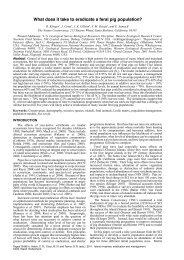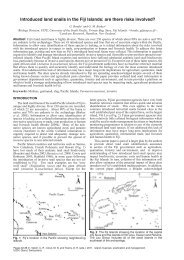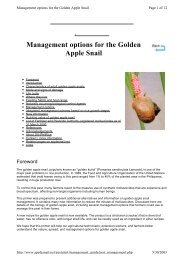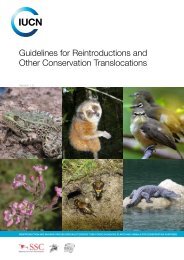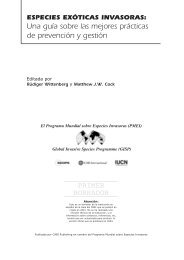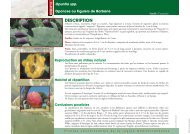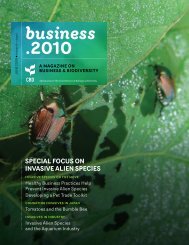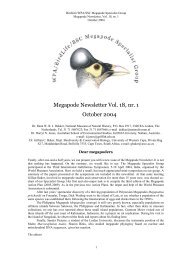Aliens Newsletter - ISSG
Aliens Newsletter - ISSG
Aliens Newsletter - ISSG
You also want an ePaper? Increase the reach of your titles
YUMPU automatically turns print PDFs into web optimized ePapers that Google loves.
across the water and as it approaches the flock the<br />
birds fly over the line and are shot with shotguns.<br />
It is relatively rare for Ruddy Ducks to leave a site<br />
when shooting is taking place. Any birds which<br />
manage to fly over the guns tend to regroup in another<br />
area, and the process is repeated. Besides<br />
shooting flying birds many birds are shot on the water<br />
surface either from cover on the bank or from<br />
the boats themselves (Fig. 5). The proportion of<br />
birds shot per visit depends on the nature of the site<br />
and the weather conditions, but typically 50–75%<br />
of the birds present are culled on any one visit. This<br />
proportion has risen in recent winters as the size of<br />
the flocks has fallen. Importantly, there is no evidence<br />
that Ruddy Ducks have abandoned traditional<br />
wintering sites to any great degree as a result of<br />
the disturbance caused by shooting.<br />
Figure 5. The picture illustrates the use of small calibre<br />
sound-moderated rifles in the breeding season. Photo: Iain<br />
Henderson<br />
During the breeding season the population is much<br />
more dispersed and birds tend to be found on smaller<br />
waters.<br />
Most breeding-season control now involves shooting<br />
birds on the water surface using small-calibre,<br />
sound-moderated rifles which cause very little disturbance<br />
to other species. The main target at this<br />
time of year is breeding females with the aim of reducing<br />
productivity. It was considered possible that<br />
productivity would rise as the population fell and<br />
there was less competition for food and breeding<br />
sites, but this appears not to have happened to any<br />
significant degree.<br />
Over 6,800 Ruddy Ducks have been culled since the<br />
eradication programme started in September 2005.<br />
However, since 2006 (when 2,290 were culled) the<br />
numbers culled annually have fallen in line with the<br />
overall decline in the population.<br />
Monitoring of progress<br />
National counts of key sites are carried annually by<br />
the Wildfowl & Wetlands Trust.<br />
Since the first survey in January 2006 there has<br />
been a large decline in numbers seen, despite a<br />
doubling of the number of sites surveyed (Hall and<br />
Cranswick, 2010). It is estimated that by January<br />
2010 the UK Ruddy Duck population had fallen<br />
to around 350 individuals, compared to between<br />
4,000 and 5,000 at the start of the programme<br />
(Fig. 6).<br />
The current population (March 2010) is estimated<br />
to be around 210 individuals.<br />
Figure 6. Approximate numbers of Ruddy Ducks in the UK, midwinter 1966/67 to 2009/10<br />
<strong>Aliens</strong> 21



